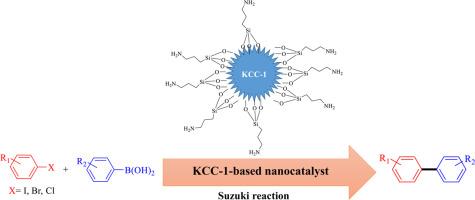KCC-1基非均相纳米催化剂在铃木反应中的应用综述
IF 2.1
3区 化学
Q3 CHEMISTRY, INORGANIC & NUCLEAR
引用次数: 0
摘要
碳-碳成键反应,特别是铃木反应,因其广泛的应用而在有机化学中受到高度重视。该反应用于制备广谱的生物和药物化合物。研究人员正在努力开发各种偶联反应的简单、廉价、快速和更有效的方法。铃木偶联反应是目前有机合成中应用广泛的交叉偶联反应。纤维纳米二氧化硅(KCC-1)作为一种高表面积、纤维可及的金属基催化剂载体材料受到了广泛关注。与传统的多孔二氧化硅不同,KCC-1提供了更好的活性位点可达性,使其成为各种有机转化的有效和环保选择,具有增强的催化性能。讨论了从钯基到铜基系统的各种kcc -1负载催化剂,重点讨论了它们的催化效率、结构特征和环境效益。本综述的主要目的是强调基于kkc -1的催化剂体系在铃木反应中用于构建有价值的联芳基化合物的用途,涵盖到2025年。本文章由计算机程序翻译,如有差异,请以英文原文为准。

A review of using KCC-1‐based heterogeneous nanocatalysts in the Suzuki reaction
Carbon-carbon bond-forming reactions, especially the Suzuki reaction, are highly valued in organic chemistry for their wide-ranging applications. This reaction is utilized to prepare a broad spectrum of biological and pharmaceutical compounds. Investigators are endeavoring to develop easy, inexpensive, rapid, and more effective procedures in various coupling reactions. The Suzuki coupling is a widely employed cross-coupling reaction in current organic synthesis. Fibrous nanosilica (KCC-1) has gained attention as a high-surface-area, fiber-accessible support material for metal-based catalysts. Unlike traditional porous silica, KCC-1 offers improved accessibility to active sites, making it an effective and eco-friendly option for various organic transformations with enhanced catalytic performance. Various KCC-1-supported catalysts ranging from palladium to copper-based systems are discussed with emphasis on their catalytic efficiency, structural features, and environmental benefits. The primary objective of this review is to highlight the utility of KKC-1-based catalyst systems in the Suzuki reaction for the construction of valuable biaryl compounds, encompassing the period up to 2025.
求助全文
通过发布文献求助,成功后即可免费获取论文全文。
去求助
来源期刊

Journal of Organometallic Chemistry
化学-无机化学与核化学
CiteScore
4.40
自引率
8.70%
发文量
221
审稿时长
36 days
期刊介绍:
The Journal of Organometallic Chemistry targets original papers dealing with theoretical aspects, structural chemistry, synthesis, physical and chemical properties (including reaction mechanisms), and practical applications of organometallic compounds.
Organometallic compounds are defined as compounds that contain metal - carbon bonds. The term metal includes all alkali and alkaline earth metals, all transition metals and the lanthanides and actinides in the Periodic Table. Metalloids including the elements in Group 13 and the heavier members of the Groups 14 - 16 are also included. The term chemistry includes syntheses, characterizations and reaction chemistry of all such compounds. Research reports based on use of organometallic complexes in bioorganometallic chemistry, medicine, material sciences, homogeneous catalysis and energy conversion are also welcome.
The scope of the journal has been enlarged to encompass important research on organometallic complexes in bioorganometallic chemistry and material sciences, and of heavier main group elements in organometallic chemistry. The journal also publishes review articles, short communications and notes.
 求助内容:
求助内容: 应助结果提醒方式:
应助结果提醒方式:


